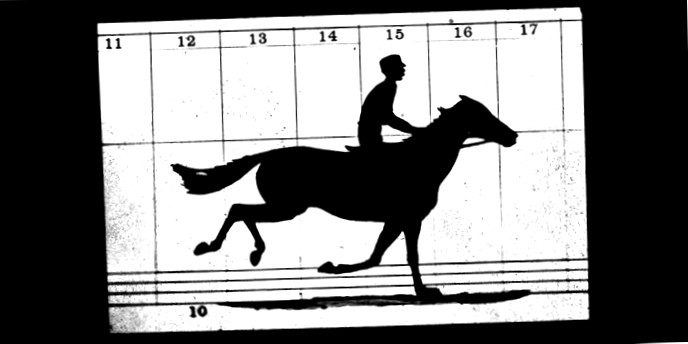
We refer to films in English as movies. This is an abbreviation for moving images or pictures, ie. Yet it is never the pictures that move. It is our eyes that see movement. Whenever rows of similar images fake them out well enough. Onlookers and creators had been experimenting with such series of images for quite some time. But photographer Eadweard Muybridge’s breakthrough came in 1872, with a horse named Sallie. The following is the prequel to the film – and about the work Sallie Gardner at a Gallop, also known as The Horse in Motion. | Reading time: 5 min.
Note: Sallie Gardner at a Gallop (1878) is the precursor to the film. && The first real moving picture (movie) is generally considered to be the Roundhay Garden Scene (1888).
The first moving pictures
Tip: The brochure Von der Camera Obscura zum Film (1992) deals with the prehistory of film using objects from the collection of Werner Nekes.
Eadweard Muybridge and etienne-Jules Marey
So why does the prequel to the film start here with Eadweard Muybridge of all people? Certainly, we could just as well have taken etienne-Jules Marey as a hook. Not infrequently these two pioneers are mentioned in one sentence.
In the 1870s, Eadweard Muybridge in California and etienne-Jules Marey in France began experimenting with the photographic recording of motion.
James Monaco
Marey was even the one who indirectly inspired Muybridge. However, with a book that Marey wrote. Muybridge, on the other hand, created the moving images we are talking about here.
Eadweard Muybridge – Biography
Born on 9. April 1830 as Edward James Muggeridge, the headstrong man changed his name for the first time at the age of 21. From then on he wrote himself Eadweard – probably in reference to a king of the same name who was once crowned in his birthplace Kingston. Eadweard left this place a little later, in 1952, to emigrate to America. An America whose west was hardly developed.
Eadweard Muybridge settled in San Francisco. This was then still a young metropolis, belonging to the USA only since 1846 and the end of the Mexican-American War. It was the time of the gold rush. In 1848 alone, the population of the town had increased from 600 to over 20.000 (!) People multiplied. Among them, Eadweard now sold books until he signed the bookstore over to his brother Thomas in 1860 and left town. In this year a violent carriage accident occurred. In the process, Eadweard suffered a serious head injury. Because this injury was cited by his lawyer many years later to declare his client insane, in the case of a revenge killing. But that is another exciting story. Read more in the English-language book The Inventor and the Tycoon (2013). &
Eadweard Muybridge – Works
Tip: Here are some illustrated books with Eadweard Muybridge’s photographs.
Eadweard Muybridge shot his first photographs in Yosemite Valley. This is a valley in what is now Yosemite National Park (the setting for the documentary Through the Wall). However, Muybridge is now most famous for those photographic works in which he experimented with capturing movement. In particular: Sallie Gardner at a Gallop (1878) and the mammoth Animal locomotion project (1887).
The Horse in Motion (1878)
Sallie Gardner at a Gallop (or: The Horse in Motion) is a series of photographs depicting a galloping horse. The pictures were taken as part of an experiment by Eadweard Muybridge on 15. June 1878. The series contains 24 individual images that could be viewed at the time in a device called a zoopraxiscope. The experiment was designed to answer the question of whether a horse at a gallop ever released all four feet from the ground simultaneously. And lo and behold: Yes, it does! By the way, Sallie Gardner was the name of the mare featured in the picture series:
Later in his career, Eadweard Muybridge worked on photo series published under the title Animal locomotion. They showed animals and people in species-typical or. everyday movements. Movements that are made visible when we observe them in rapid succession in individual images. Here are some impressions from these remarkable precursors to film history: